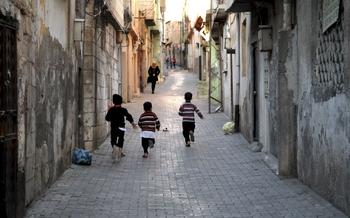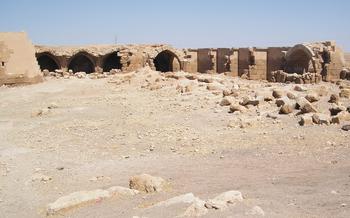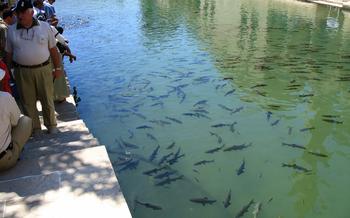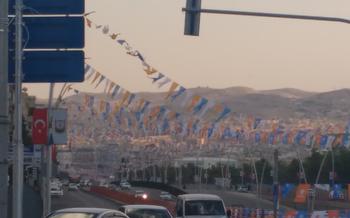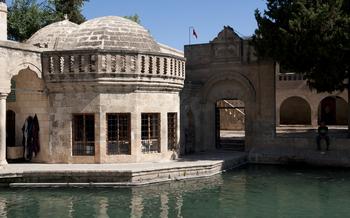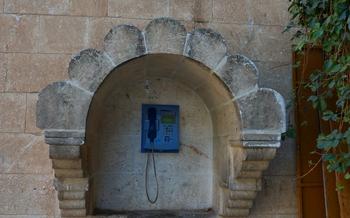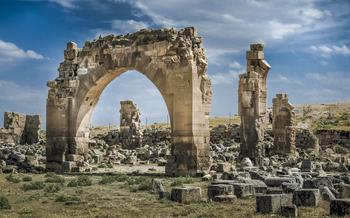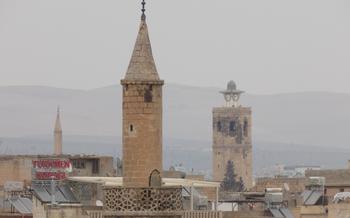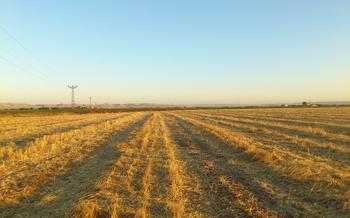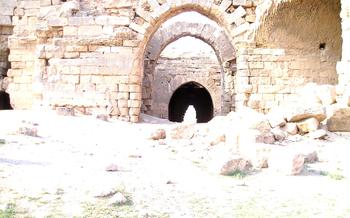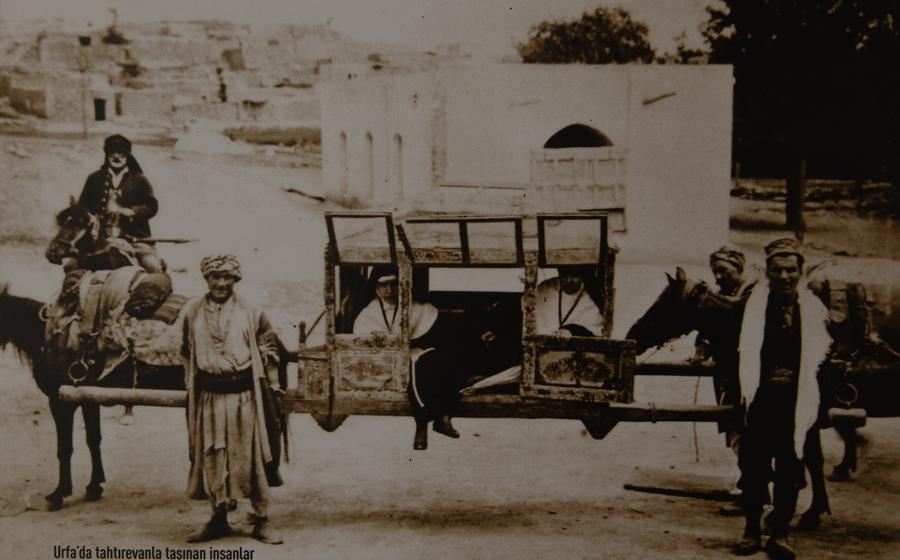
Urfa's Old City Walls
- A Journey Through Time: Exploring Urfa's Ancient City Walls
- Unveiling the Layers of History
- A Stroll Along the Fortified Walls
- The Gates of Urfa: Portals to the Past
- The Great Mosque of Urfa: A Sacred Landmark
- The Pool of Abraham: A Place of Reverence
- The Cave of Abraham: A Holy Site
- The Museum of Şanlıurfa: A Treasure Trove of History
- The Zeugma Mosaic Museum: An Artistic Masterpiece
- The Göbeklitepe Archaeological Site: A Neolithic Wonder
- Historical Significance and Uniqueness of Göbeklitepe
- Location and Accessibility of the Site
- Notable Features and Structures at Göbeklitepe
- Tips for Planning a Visit to the Site
- Savoring the Local Cuisine: A Culinary Adventure
- Shopping for Local Treasures: The Old Bazaar
- Exploring the Natural Wonders: Harran and Beyond
- Insider Tip: Unveiling the Hidden Gems
A Journey Through Time: Exploring Urfa's Ancient City Walls
Şanlıurfa, a city steeped in history and culture, boasts an impressive array of ancient city walls that have stood the test of time. These awe-inspiring fortifications, dating back to the Roman period, encircle the city's old quarter, creating a palpable sense of history and grandeur.
Strategically positioned atop a hill, the walls provided a formidable defense against invaders, ensuring the safety and prosperity of Urfa's inhabitants. Their construction reflects the engineering prowess of ancient civilizations, showcasing sophisticated architectural techniques and the use of durable materials like basalt and limestone.
The walls stand as a testament to Urfa's rich cultural heritage, having witnessed the rise and fall of empires, the blending of civilizations, and the convergence of diverse religious traditions. They embody the city's resilience and its ability to adapt to the ever-changing tides of history.
Moreover, the walls hold immense religious significance, particularly for Muslims and Christians. They are believed to have been built by the Prophet Abraham, who is revered as the father of monotheism. This association has transformed Urfa into a pilgrimage site, attracting visitors from around the world who come to pay homage to the city's sacred landmarks.
Unveiling the Layers of History
Urfa's ancient city walls stand as silent witnesses to the many civilizations that have graced this land over the millennia. Archaeological excavations conducted in and around the city have unearthed a treasure trove of artifacts, shedding light on the rich and varied history of the region. From the mighty Akkadian Empire to the Hellenistic Seleucids and the Roman Republic, each era has left its mark on Urfa's urban landscape.
Among the most intriguing discoveries are the numerous cuneiform tablets found at various sites within the city walls. These tablets, inscribed in the ancient Akkadian language, provide valuable insights into the political, economic, and cultural life of the city during the Bronze Age. They reveal the existence of a sophisticated urban civilization that engaged in extensive trade and diplomatic relations with neighboring regions.
In addition to the tangible remains, the walls themselves hold many stories and legends that have been passed down through generations. One of the most famous tales is that of the "Seven Sleepers," a group of Christian youths who are said to have slept for over 300 years in a cave near the city. When they awoke, they found that Christianity had become the dominant religion in the Roman Empire, and they were hailed as saints.
The city walls of Urfa are not merely historical relics; they also played a crucial role in shaping the city's identity. They provided protection from invaders, facilitated trade and commerce, and served as a symbol of the city's strength and resilience. Over the centuries, the walls have been repaired and reinforced, reflecting the city's changing fortunes and the enduring spirit of its people.
A Stroll Along the Fortified Walls
For a comprehensive exploration of Urfa's ancient city walls, start your journey at the Urfa Castle, located at the heart of the old city. From there, embark on a leisurely walk along the Bedo Fortress, which offers breathtaking views of the city and the surrounding countryside. The Gökpınar Fortress is another must-see, showcasing impressive fortifications and stunning architecture.
The walk along the walls is relatively easy and accessible, taking approximately 2-3 hours. Be sure to bring comfortable shoes and a camera to capture the remarkable sights along the way. The panoramic views from the citadel and the fortifications are not to be missed, providing a unique perspective of the city's rich history and architectural heritage.
Along the walk, you'll encounter several notable landmarks and viewpoints. The Urfa Castle, with its imposing towers and ramparts, offers a glimpse into the city's past as a strategic fortress. The Bedo Fortress, with its intricate carvings and inscriptions, tells stories of past civilizations and their architectural prowess.
To enhance your experience, consider joining a guided tour or hiring a local guide. They can provide valuable insights into the history, culture, and significance of the city walls, making your walk even more informative and enjoyable.
The Gates of Urfa: Portals to the Past
In ancient times, city gates served as more than mere entrances and exits; they were symbols of power, protection, and prestige. Urfa's city gates, with their imposing presence and architectural grandeur, are testaments to the city's rich history and cultural heritage.
The most prominent of these gates is the Harran Gate, also known as the Gate of the Moon. Located on the eastern side of the city, the Harran Gate is a stunning example of Islamic architecture, featuring intricate carvings and decorative elements.
Another significant gate is the Rumkale Gate, situated to the west of the city. This gate leads to the ancient city of Rumkale, perched atop a hill overlooking the Euphrates River. The Rumkale Gate is a reminder of the city's strategic importance as a trading hub and a gateway to the East.
The Tell Halaf Gate, located on the northern side of the city, is another impressive gate that once provided access to the ancient city of Tell Halaf, renowned for its magnificent sculptures and artifacts.
Each of these gates holds its own unique story, embodying the diverse cultural influences that have shaped Urfa throughout history. Visiting these gates offers a glimpse into the city's past and a chance to appreciate the architectural legacy of civilizations gone by.
The Great Mosque of Urfa: A Sacred Landmark
In the heart of Şanlıurfa, the Great Mosque stands as a testament to the city's rich Islamic heritage. Believed to be built on the site of a former temple dedicated to the moon god Sin, the mosque holds a prominent position in the city's spiritual and cultural landscape.
The mosque's architectural features are awe-inspiring, showcasing a blend of Seljuk and Ottoman influences. Its grand courtyard, adorned with intricate tilework and elegant arches, leads to the main prayer hall, where rows of ornate columns support a breathtaking dome. The interior is adorned with intricate calligraphy, colorful stained-glass windows, and shimmering chandeliers, creating an atmosphere of tranquility and devotion.
As a functioning mosque, the Great Mosque is a hub of religious activity, where locals and visitors alike gather for daily prayers and religious ceremonies. The mosque also serves as a center for Islamic learning and scholarship, with a library housing a vast collection of religious texts and manuscripts.
For visitors, the Great Mosque offers a glimpse into the spiritual heart of Şanlıurfa. While non-Muslims are not permitted to enter the prayer hall during prayer times, they are welcome to visit the mosque's courtyard and admire its architectural splendor from afar. It is advisable to dress respectfully and observe local customs when visiting the mosque.
The Pool of Abraham: A Place of Reverence
In the heart of Şanlıurfa, a sacred site holds immense religious significance for both Muslims and Christians. The Pool of Abraham, also known as the Halil-ur-Rahman Lake, is a revered destination that attracts pilgrims and tourists alike. According to Islamic tradition, the pool is believed to be the place where the prophet Abraham was thrown into a fire by Nimrod, a tyrannical king. Miraculously, the fire turned into water, and Abraham emerged unscathed.
The pool is located within the complex of the Halil-ur-Rahman Mosque, a beautiful structure that complements the serene atmosphere of the site. Visitors can immerse themselves in the tranquil surroundings, marveling at the intricate Islamic architecture and the shimmering waters of the pool. Local legends and stories associated with the pool add to its mystique, enhancing its spiritual allure.
Whether seeking spiritual enlightenment or simply appreciating historical significance, the Pool of Abraham offers a unique and awe-inspiring experience. Visitors can wander around the tranquil gardens, soak in the serene atmosphere, and reflect on the miraculous events that are said to have taken place here. It is a truly special place that invites contemplation and reverence.
The Cave of Abraham: A Holy Site
Religious Significance and Symbolism:
The Cave of Abraham holds immense religious significance for Muslims, who believe that the prophet Ibrahim (Abraham) sought refuge in this cave during his journey from Ur to Canaan. According to Islamic tradition, Abraham and his family stayed in the cave for a period of time, and it is believed that the cave was where Abraham's wife, Sarah, gave birth to their son, Isaac. The cave is revered as a holy site and is often visited by pilgrims and tourists seeking blessings and spiritual connection.
Location and Accessibility:
The Cave of Abraham is situated in the southeastern part of Şanlıurfa, approximately 10 kilometers from the city center. It can be easily reached by public transportation or taxi. Visitors can walk up to the cave through a scenic path that leads to the entrance.
Legends and Stories:
The Cave of Abraham is associated with numerous legends and stories that have been passed down through generations. One popular legend tells of how Abraham's pursuers were blinded by a divine light as they approached the cave, preventing them from capturing him. Another story recounts how Abraham's prayers in the cave resulted in a spring of water gushing forth, providing sustenance for him and his family during their stay.
Visiting the Cave:
The Cave of Abraham is open to visitors throughout the year. It is a popular destination for both religious pilgrims and tourists seeking a glimpse into the history and spirituality of the region. Visitors can explore the cave's interior, which features a simple altar and a niche where Abraham is believed to have prayed. Many visitors choose to light candles or offer prayers within the cave as a way of paying homage to the prophet.
The Museum of Şanlıurfa: A Treasure Trove of History
The Museum of Şanlıurfa, situated in the heart of the city, stands as a testament to the rich history and cultural heritage of the region. Within its walls, a treasure trove of artifacts and exhibits awaits visitors, offering a journey through the ages that shaped Şanlıurfa's identity.
The museum's collection spans various eras, from prehistoric times to the present day, showcasing the diverse civilizations that have left their mark on the city. Among the highlights are artifacts from the Neolithic period, including the world-renowned Göbeklitepe findings, which provide a glimpse into the origins of human civilization.
Other must-see exhibits include Bronze Age pottery, Assyrian reliefs, Hellenistic sculptures, and Islamic manuscripts, each narrating a chapter in the city's story. The museum's displays are thoughtfully curated, providing historical context and insights into the significance of each artifact.
The museum building itself is a testament to the city's architectural legacy. Constructed in the early 20th century, it blends traditional Islamic elements with modern design, creating a harmonious space for showcasing the region's cultural treasures.
To fully appreciate the museum's offerings, allow ample time for exploration. Plan your visit during the museum's operating hours, typically from 8 am to 5 pm daily, except on Mondays. Guided tours are available for a more comprehensive understanding of the exhibits.
Immerse yourself in the Museum of Şanlıurfa, and let the whispers of history guide you through the remarkable journey of this ancient city.
The Zeugma Mosaic Museum: An Artistic Masterpiece
The Zeugma Mosaic Museum houses a stunning collection of ancient mosaics that were once part of the opulent villas of the ancient city of Zeugma, situated on the banks of the Euphrates River. These intricate and exquisitely crafted mosaics depict scenes from mythology, daily life, and religious beliefs, offering a glimpse into the vibrant culture and artistry of the region.
The museum's star attraction is the "Gypsy Girl" mosaic, a captivating portrait of a young woman with piercing eyes and an enigmatic smile. This masterpiece, along with other well-preserved mosaics, showcases the exceptional skill and artistry of ancient mosaicists. The museum's collection also includes mosaics depicting hunting scenes, chariot races, and mythological figures such as Dionysus and Medusa.
Located in the heart of Şanlıurfa, the Zeugma Mosaic Museum is easily accessible and offers a fascinating journey through the artistic heritage of ancient Zeugma. Visitors can admire the intricate details and vibrant colors of these ancient artworks, gaining insights into the lives and beliefs of the people who once inhabited this region.
The Göbeklitepe Archaeological Site: A Neolithic Wonder
Historical Significance and Uniqueness of Göbeklitepe
Among the wonders of Şanlıurfa, Göbeklitepe stands out as a site of immense historical significance. Dating back to the Neolithic period, around 10,000 years before the construction of the Egyptian pyramids, Göbeklitepe predates Stonehenge by 6,000 years, making it the world's oldest known temple. This ancient site challenges our understanding of human civilization and offers a glimpse into the origins of religious practices and monumental architecture.
Location and Accessibility of the Site
Göbeklitepe is situated approximately 15 kilometers northeast of Şanlıurfa city center. It is easily accessible by road, with well-paved roads leading to the site. Visitors can drive or take a taxi to reach Göbeklitepe, and guided tours are also available from the city.
Notable Features and Structures at Göbeklitepe
The most striking features of Göbeklitepe are its large, circular stone structures, known as enclosures. Each enclosure is made up of massive T-shaped pillars arranged in a circular pattern. These pillars are intricately carved with various animal motifs, including lions, bulls, foxes, and birds. The carvings and sculptures provide valuable insights into the symbolic beliefs and iconography of the Neolithic people.
Tips for Planning a Visit to the Site
To make the most of your visit to Göbeklitepe, consider the following tips:
- Plan your visit during the spring or fall to avoid the extreme summer heat.
- Wear comfortable shoes as the site involves some walking on uneven terrain.
- Bring a hat and sunscreen to protect yourself from the sun.
- Guided tours are available on-site and are highly recommended to gain a deeper understanding of the site's history and significance.
- Photography is permitted, but flash photography is not allowed to preserve the integrity of the carvings.
Savoring the Local Cuisine: A Culinary Adventure
Şanlıurfa is not just a treasure trove of historical and cultural wonders but also a haven for food lovers. The city's cuisine is a blend of flavors, influenced by its rich history and diverse cultural heritage. Here, you can embark on a culinary adventure and savor mouthwatering dishes that will tantalize your taste buds.
Must-Try Dishes and Specialties of Şanlıurfa Cuisine
Şanlıurfa is renowned for its unique and delectable dishes. One must-try is the famous Urfa kebab, succulent grilled meat skewers seasoned with local spices and served with roasted vegetables. Another specialty is lahmacun, a thin and crispy flatbread topped with minced meat, vegetables, and herbs, baked in a stone oven.
For a vegetarian delight, try çiğ köfte, a spicy raw meatball dish made with bulgur, minced vegetables, and spices. And don't miss şıllık, a traditional soup made with lamb or beef broth, chickpeas, and dumplings.
Recommended Restaurants and Eateries for Authentic Flavors
To experience the true essence of Şanlıurfa cuisine, head to the local restaurants and eateries. For a taste of traditional kebabs, visit Kebapçı Halil Usta or Ömür Kebap. For authentic lahmacun, try Lahmacuncu Ali Usta or Lahmacuncu Ahmet Usta.
For a unique dining experience, indulge in a meal at Hanedan Sofrası, a restaurant housed in a historic mansion, offering a delightful ambiance and a menu of local specialties. Şanlıurfa Sofrası is another popular choice, serving a wide range of Urfa dishes in a cozy and welcoming setting.
Unique Ingredients and Culinary Traditions of the Region
Şanlıurfa cuisine is distinct for its use of local ingredients and traditional cooking techniques. One unique ingredient is Urfa biber, a spicy pepper that adds a fiery kick to many dishes. Şanlıurfa fıstığı, a variety of pistachio, is another local specialty, often used in desserts and snacks.
The region's culinary traditions reflect its nomadic past. Dishes like çiğ köfte and şıllık are believed to have originated from nomadic tribes who needed portable and nutritious meals. The use of spices and herbs, such as cumin, paprika, and sumac, is also a testament to the region's rich culinary heritage.
Food Festivals and Events to Experience Local Cuisine
To immerse yourself fully in the culinary delights of Şanlıurfa, be sure to attend one of the many food festivals and events held throughout the year. The Urfa Food Festival, held annually in October, is a grand celebration of local cuisine, showcasing the best dishes and flavors the city has to offer.
Another notable event is the Şanlıurfa Gastronomy Days, which takes place in November and features cooking demonstrations, workshops, and tastings, allowing visitors to learn about and savor the region's rich culinary heritage.
Shopping for Local Treasures: The Old Bazaar
Immerse yourself in the vibrant atmosphere of Şanlıurfa's Old Bazaar, a treasure trove of local handicrafts, spices, and souvenirs. Located in the heart of the city, this bustling marketplace has been a hub of trade and cultural exchange for centuries.
As you wander through the labyrinthine alleys, you'll be greeted by a symphony of sights, sounds, and aromas. Vendors proudly display their wares, from intricately woven carpets and hand-painted ceramics to glistening copperware and aromatic spices.
Bargaining is an essential part of the shopping experience here. Don't be afraid to engage in friendly negotiations with the shopkeepers; it's not just about getting a good price but also a way to connect with the locals and learn about their culture.
In addition to traditional Turkish handicrafts, the Old Bazaar is also known for its culinary delights. Sample local specialties such as kebabs, gözleme, and künefe, or indulge in the sweet temptation of freshly made baklava.
Whether you're looking for unique souvenirs, delicious snacks, or simply a glimpse into the vibrant heart of Şanlıurfa, the Old Bazaar is a must-visit destination. Embrace the local customs, strike up conversations with the friendly vendors, and let the spirit of the bazaar captivate you.
Exploring the Natural Wonders: Harran and Beyond
Venture beyond the city limits of Şanlıurfa to discover the captivating natural wonders that await. Harran, a town steeped in history and renowned for its distinctive beehive-shaped houses, is a must-visit destination. These unique dwellings, constructed from mud bricks and domed roofs, have stood the test of time and offer a glimpse into the region's rich architectural heritage.
In addition to Harran, Şanlıurfa boasts a wealth of natural attractions within easy reach. Embark on a day trip to explore the stunning landscapes and serene surroundings that embrace the city. Discover hidden waterfalls, lush forests, and picturesque villages nestled amidst rolling hills. Whether you seek tranquility or adventure, nature enthusiasts will find ample opportunities to immerse themselves in the region's natural beauty.
For a truly immersive experience, consider venturing off the beaten path and exploring lesser-known natural gems. Seek out local recommendations or engage the services of a knowledgeable tour guide to uncover hidden trails, secluded waterfalls, and breathtaking viewpoints. Embrace the opportunity to connect with nature, escape the urban hustle, and create lasting memories in the enchanting surroundings of Şanlıurfa.
Insider Tip: Unveiling the Hidden Gems
Beyond the renowned attractions, Şanlıurfa offers a treasure trove of hidden gems waiting to be discovered. For those seeking an authentic and immersive experience, venturing off the beaten path is highly recommended. Explore the lesser-known historical sites, such as the Akçakale Fortress or the Siverek Castle, which offer a glimpse into the region's rich past. Immerse yourself in the vibrant local culture by attending traditional festivals like the Şanlıurfa International Music Festival or the Harran Culture and Art Festival, where you can witness captivating performances, exhibitions, and culinary delights. To delve deeper into the local way of life, engage with the friendly locals, savor traditional cuisine at family-run restaurants, and visit the bustling markets to discover unique handicrafts and regional specialties.
For nature enthusiasts, a day trip to the nearby Harran Plain is a must. Explore the fascinating beehive houses, a unique architectural wonder, and immerse yourself in the serene landscapes that surround them. Alternatively, embark on a trekking adventure in the Karacadağ Mountains, where stunning views and diverse flora and fauna await. To uncover the hidden culinary gems of Şanlıurfa, seek out local eateries that serve authentic dishes such as "Urfa kebabı," "lahmacun," and "şıllık tatlısı." These culinary delights, bursting with flavors and aromas, will tantalize your taste buds and leave you craving for more.
To make the most of your exploration, consider hiring a local guide who can provide insights into the history, culture, and traditions of Şanlıurfa. They can lead you to hidden gems that are often overlooked by tourists and tailor your experience based on your interests. Whether you're seeking historical wonders, cultural immersion, or culinary adventures, Şanlıurfa offers a wealth of experiences beyond its famous landmarks, ensuring an unforgettable journey for every traveler.
